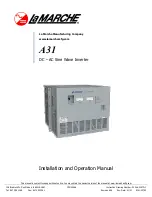
1 1
. CHECkINg THE SOLAR POWER SySTEM INSTALLATION LOCATION
COdE COMPLIANT INSTALLATION
1. Determine the wind loads for the installation site.
Check with your local building and safety department
for the specific requirements.
2. Make certain that the roof structure can support the
live and dead loads resulting from the installation of
the PV array.
3. Consult with a professional engineer if additional
assistance is required.
4. Determine the basic wind speed from the IBC wind
speed chart (for US locations).
5. Determine the exposure category A through D (obtain
latest definitions from IBC or local building code).
6. Determine total pressure by compiling basic wind
speed, exposure and roof height. Check with Sharp
technical support if your total pressure exceeds 45 PSF.
7. Reference the chart wind speeds to determine your
design wind pressure (PSF). Determine exposure
categories A through D for various roof heights.
8. Based on the loading in step 7, make certain that the
roof structure can support the load.
9. The modules and system are UL listed to standard
1703. The UL 1703 test is performed at 1.5 times the
design load of 30 lbs per square foot, or 45 lbs per
square foot. The system has been load tested by
Sharp to 50 PSF. Building departments often require
a design safety factor of 1.5 or greater for structures.
The maximum structural loading listed in this guide
does not include an added safety factor.
10. To achieve maximum load capacity, use at least
the same number of sliders as modules on each rail.
bASIC WINd SPEEd SPECIFIEd by IbC
IbC Wind Speed Chart
90 (40)
90 (40)
90 (40)
90 (40)
90 (40)
100 (45)
100 (45)
100 (45)
100 (45)
110 (49)
110 (49)
110 (49)
110 (49)
120 (54)
120 (54)
120 (54)
120 (54)
130 (58)
130 (58)
130 (58)
130 (58)
130 (58)
140 (63)
140 (63)
140 (63)
140 (63)
140 (63)
140 (63)
140 (63)
150 (67)
150 (67)
150 (67)
Location
V mph
(m/s)
Hawaii
105
(47)
Puerto Rico
145
(65)
Guam
170
(76)
Virgin Islands
145
(65)
American Samoa
125
(56)
Notes:
1. Values are nominal design 3-second gust wind speeds in miles per hour (m/s)
at 33 ft. (10 m) above ground for Exposure C category.
2. Linear interpolation between wind contours is permitted.
3. Islands and coastal areas outside the last contour shall use the last wind speed
contour of the coastal area.
4. Mountainous terrain, gorges, ocean promontories, and special wind regions
shall be examined for unusual wind conditions.
2006 International Building Code - Basic Wind Speed (3-second gust)
POINTS TO CHECk WHEN SELECTINg THE INSTALLATION LOCATION
Содержание SRS Mounting System
Страница 41: ...NOTES ...












































